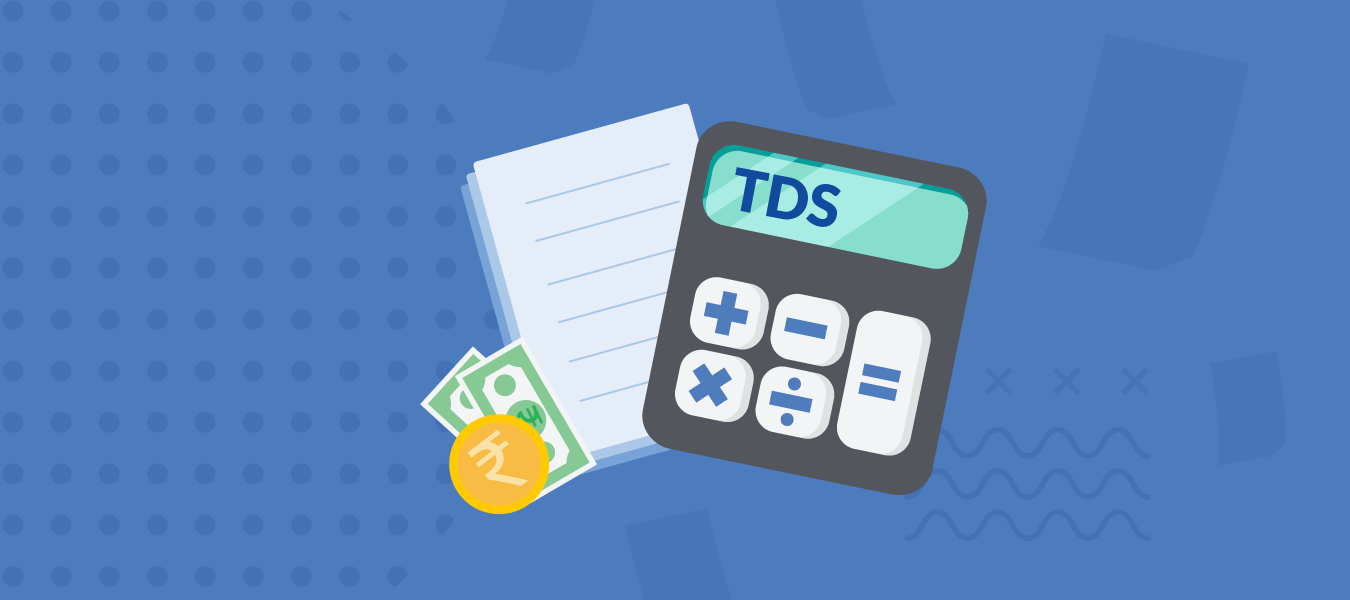How To Calculate TDS on Salary?
Calculate TDS on salary – FAQs
TDS on Salary: What is it?
TDS is utilized to collect Income Tax from working professionals as per the Income Tax Act, 1961.
This tax is applicable levied on commissions, salary, brokerage, royalty payments, investment returns, contract payments, or any other type of gains.
The TDS is collected and managed by the CBDT or Central Board for Direct Taxes, which is a part of the Department of Revenue. The TDS amount received by the government is collected to achieve stable revenue and prevent tax evasion.
Understanding Salary Income
To understand how to calculate TDS on salary income, you must first understand salary income. The salary of an individual is the regular amount of money received in return for providing services or skills. This income includes pension, wage, annuity, perquisites, fees, commissions, gratuity, etc.
There are other professional benefits which are not included in the salary such as profits, interest income, rental income, commission payments, professional fees, etc.
What Factor(s) Determine TDS?
TDS is calculated by deducting exemptions and the amount (also referred to as deductions) from your salary.
Exemptions
Every company’s CTC structure includes certain allowances on housing/accommodation, travel expenses, medical allowance, and so on. These components of the income put together is termed as exemptions.
The details of such exemptions, including the maximum amount that is considered can be found under Section 10 of the Income Tax Act. Popular exemptions include:
- House Rent Allowance
- Leave Travel allowances
- Gratuity
- Medical allowance
Deductions
As for the deduction, it’s an assemblage of tax-saving options that reduce tax liability. One such deduction is called Standard Deduction which is available to all taxpayers. It amounts to INR 50,000 which is deducted from the gross salary, thereby reducing the gross taxable income.
Apart from the standard deduction, there are several other tax deductions you can claim to further reduce your taxable income. These are mostly investment options under Section 80C which allows employees to save, invest, and spend money (for returns) on instruments with different lock-ins and market risks.
A few deductions under Section 80C include Public Provident Fund (PPF), 5-year Tax Saving Fixed Deposit, National Pension System (NPS), Unit Linked Insurance Plans (ULIPs), and so on.
Other deductions include a contribution towards medical expenses for dependents under Section 80D, and expenses on education under Section 80E.
How To Calculate TDS on Salary?
Here are the steps that’ll help to calculate TDS on salary:
Step 1
Find out the gross monthly income. This can be done by adding monthly basic income, perquisites (bonuses/incentives), and allowances. For example, consider the gross monthly salary as INR 80,000.
Step 2
Calculate all available exemptions and reduce the total from the gross monthly income. TDS is calculated on the annual income received every year so to arrive at the annual taxable income, subtract exemptions from gross monthly income and multiply the resulting figure by 12.
For instance, assume that the gross monthly income includes the following allowances:
- Travel Allowance: INR 800
- Medical Allowance: INR 1,250
- Child Education Allowance (CEA): INR 200
So, your annual taxable income becomes:
Annual Taxable Income = [ 80000 – ( 800 + 1250 + 200 ) ] x 12 = INR 9,33,000
Step 3
Subtract yearly investments from the Annual Taxable Income calculated in Step 2.
Step 3.1
Assume that one of the yearly investments was actually a loss on a housing loan repayment which amounts to INR 1,50,000. Then, the new annual taxable income will be:
(New) Annual Taxable Income = 9,33,000 – 1,50,000 = INR 7,83,000
Step 3.2
Also, deduct investments under Section 80C and 80D from the annual taxable income acquired in Step 3.1. For example, the employee invests INR 1.2 lakh under Section 80C and INR 30,000 under Section D. then the new annual taxable income will be:
(New) Annual Taxable Income = 7,83,000 – ( 1,20,000 + 30,000) = INR 6,33,000
Step 4
Arrive at the final annual taxable income and calculate the TDS deduction on salary with the help of old and the new income tax slabs with TDS rate on salary income. In this case, the income tax slabs will be for individuals below 60 years of age.
.
To Sum Up…
-
Assess Total Earnings
The employer must first figure out the total earnings of the employee before calculating TDS.
-
Declaration
Obtain a declaration from an employee about the investments. This should then be followed up by proof of investment at the end of the year. Failure to collect these documents results in missing out on exemptions.
-
Total Tax Exemption
Discount the exemptions and deductions from the gross annual salary to find the total taxable income. Calculate tax on this income based on the tax slab of the employee.
-
Deposit TDS
In the last step, the TDS amount is to be deposited with the Central Government year before the end of the fiscal year.
Conclusion
TDS is an important deduction which is made from the income of every professional. Even if your employer or payee fails to deduct this tax or pay it to the government, the employee or professional still needs to submit this tax at the time of tax returns. This means that you should always keep a note of the tax being deducted from your salary or income.
Calculate TDS on salary – FAQs
- Can deduction on HRA be claimed for TDS?
Deduction on HRA can be claimed for TDS. But you need to declare the total amount that you pay as rent and back it up with evidence for it to be exempted. You can provide rent receipts with revenue stamp and landlords signature, bank cheques or details of online money transfers made to the landlord’s bank account(s). - While calculating TDS, how much can be claimed under Section 80C for a deduction?
As per the Income Tax Act of India, you can claim up to INR 1.5 lakh as an exemption. - Is there a way to know the amount of tax deducted by the payer from the income?
Yes. You can check Form 26AS under the ‘’View Your Tax Credit’’ facility on the Income Tax Portal. Alternatively, you can request the payer to provide a TDS certificate. - Does the payee face any penalties when the payer does not deduct TDS?
As the payee, while filing returns you must pay your tax liability. In other words, you are eligible to pay taxes even though the payer does not deduct. The responsibility of deducting TDS rests on the payer, so NO, you do not have to face any consequences if TDS is not deducted by the payer. - Why doesn’t TDS credit reflect in the Form 26AS?
TDS credit does not show in Form 26AS due to any of the following reasons:- TDS statement has not been filed by the payer
- Payer has not deposited the tax collected
- While filing the TDS statement, the payer might have incorrectly quoted payee’s PAN details
In case you do not see TDS credit details in Form 26AS, inform your payer immediately and request them to rectify any errors.
Related Articles









